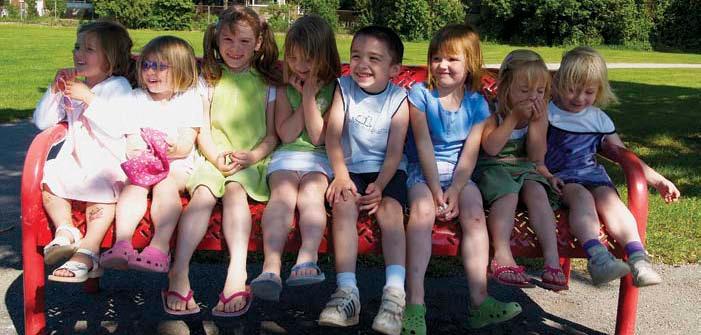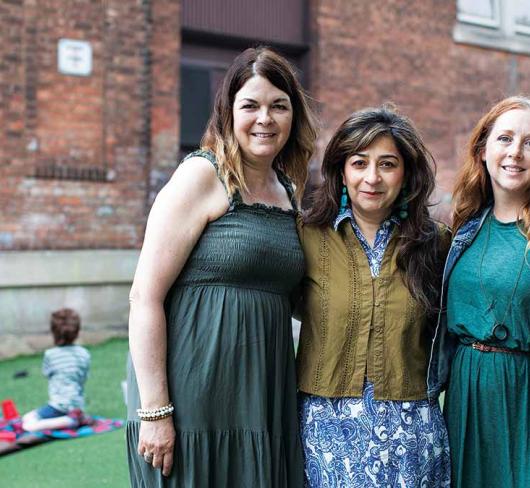
Imagining a Future: Full-Day Kindergarten: a Boost For Children Living in Poverty
During the 2007 provincial election, the Ontario government promised to significantly reduce poverty and its effects. To deliver on this commitment, the government will have to adopt a multi-pronged approach in which education plays an important role. The government’s plan for full-day junior and senior kindergarten will benefit all children, but particularly children from disadvantaged families.
Poverty can limit student success
Research shows and teachers understand that children from disadvantaged backgrounds are less likely to succeed academically and ultimately are at greater risk of failing to graduate from high school. The Organization for Economic Cooperation and Development (OECD) conducted a comprehensive overview of national education programs, which found that children from families with low socioeconomic status are less likely to develop the same level of skills and “intellectual capital” as children from more advantaged backgrounds. The OECD has also reported that, based on the 2001 and 2004 PISA* reading, math, and science tests, lower educational outcomes are clearly linked to family poverty.1 Failure to succeed at school has significant implications for these students’ futures and for Ontario’s social and economic welfare.
The OECD found that Canada was one of the few member countries able to compensate to some degree for socioeconomic disadvantage through significant investment in public education: “The school systems in some countries, e.g. in Australia, Canada, Finland and Japan, manage to compensate for socioeconomic disadvantage and ensure that children from low-income families do not fall irretrievably behind in academic achievement.”2 While Canada’s public school system deserves high marks for its inclusiveness, much more needs to be done both nationally and provincially to narrow the gap in achievement for children from low-income families.
The benefits of universal early learning
A number of developed nations view universal early childhood education as an effective social policy to address these issues. “International research from a wide range of countries shows that early intervention contributes significantly to putting children from low-income families on the path to development and success in school.”3 Most European countries provide universal educational programs for children three to five years old and make them available to any child regardless of parental employment status or family income. The programs are delivered through a body equivalent to our ministry of education. In most cases they are taught by university-trained teachers.
Increasingly, European countries are going even further by offering programs for children younger than three. In Denmark, Finland, and Sweden, where the compulsory school age is seven, high-quality early childhood education programs are made universally accessible and afford able through significant public investment and a fee structure based on parental income. Programs for children three and under are also available in Belgium, Italy, and Portugal.
The commitment of many European countries is reflected in their level of spending. Among the OECD nations, public spending for early learning and child care ranges between 0.2 to 2 per cent of gross domestic product (GDP). Canada ranks lowest among the 14 countries for which data is provided. Denmark, Sweden, Norway, and Finland spend the most; the United States is in ninth place – ahead of Canada.4
Narrowing the achievement gap
Introducing full-day kindergarten moves countries like Canada and the United States that don’t have universal programs for younger children a step closer to the European model.
The United States is ahead of Canada in this regard. Enrolment of five-year-olds in publicly funded full-day kindergarten increased to 63 per cent in 2000 from 25 per cent in 1979. There is also an increasing focus on enrolling four-year-olds from lower socioeconomic backgrounds in pre-kindergarten (our JK).5 The expansion of full-day programs is based on research that demonstrates the academic improvement these students achieve in terms of literacy and math skills, especially the former. These findings have been echoed by recent Canadian longitudinal research as well. A study of Edmonton public schools begun in 2000-01 concluded:
It is clear that a full-day kindergarten experience enables children, particularly those from educationally deprived backgrounds, to acquire the skills needed to become emergent readers at least to the point at which they are at par with children from more educationally advantaged communities.6
Other studies point to the benefits of full-day kindergarten programs for immigrant or refugee children whose first language is neither English nor French. Such programs offer important opportunities for the expanded and intensified learning these children need to make a successful transition to grade 1. Given the recent trends in immigration to Ontario, this benefit will become increasingly important.
Beyond full-day kindergarten
Expanding kindergarten to full-day is just one way school programs can address poverty. Clearly, to deal with the issues that disadvantaged children bring with them to the classroom, schools require myriad resources and programs. These include school nutrition programs, early identification and intervention with the support of board psychologists, and expansion of programs that go beyond the focus on literacy and numeracy. ETFO’s Close the Gap campaign to achieve equal funding is aimed at providing a more enriched and balanced program for elementary students. The goal is to ensure that all elementary students benefit from smaller classes, teacher-librarians, and the important programs provided by specialist teachers. Such improvements will benefit all students, and also go a long way toward narrowing the gap in opportunities and experiences for children with low socioeconomic status.
Notes
1. OECD. Starting Strong II: Early Childhood Education and Care, Paris, 2006.
2. Ibid., pp. 35.
3. Ibid., pp. 35-36
4. Martha Friendly. Early Learning and Child Care: How Does Canada Measure Up? Childcare Resource and Research Unit, University of Toronto, Toronto: 2006.
5. Education Commission of the States. Full-Day Kindergarten: A Study of State Policies in the United States, Denver, 2005.
6. José da Costa. “Full-day Kindergarten: Longitudinal Effects Through Grade Three.” International Journal of Learning, 12 (6), pp. 15-36.

